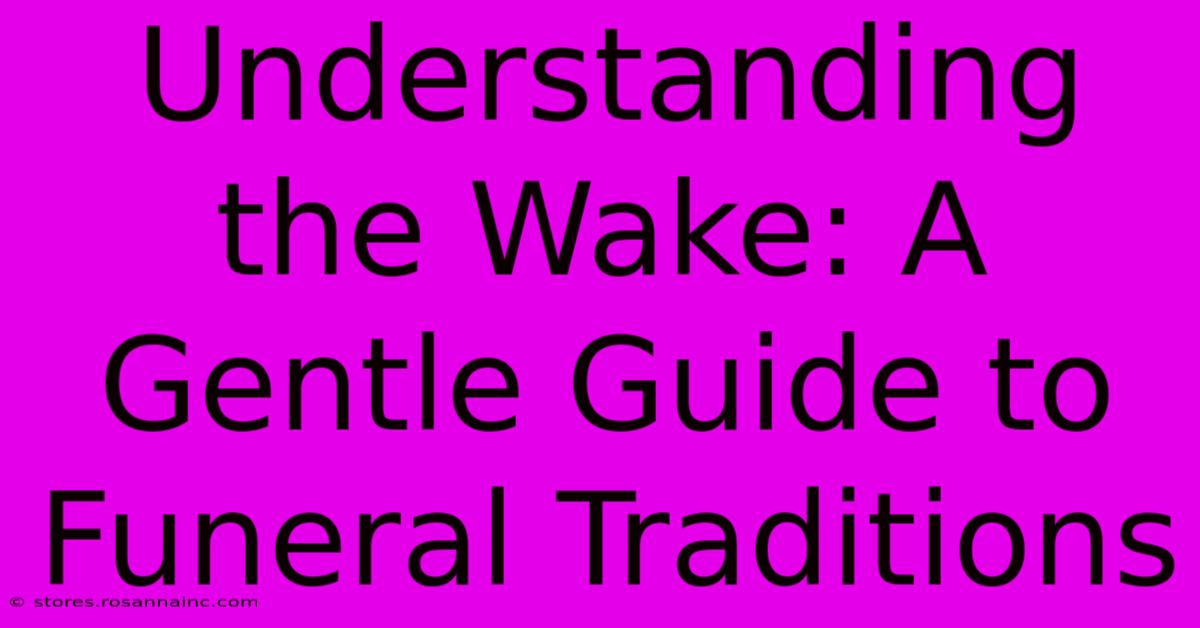Understanding The Wake: A Gentle Guide To Funeral Traditions

Table of Contents
Understanding the Wake: A Gentle Guide to Funeral Traditions
Death is a universal experience, yet the ways we grieve and commemorate our loved ones vary widely across cultures and faiths. One common tradition, particularly in certain Western cultures, is the wake. This guide offers a gentle introduction to understanding wakes, their purpose, and the customs associated with them.
What is a Wake?
A wake, also known as a visitation or viewing, is a gathering held before a funeral service. It provides an opportunity for family and friends to pay their respects to the deceased, offer condolences to the bereaved, and share memories of the person who has passed. It's a time for reflection, remembrance, and communal support during a period of intense grief. Think of it as a prelude to the formal funeral service, allowing for a more informal and intimate expression of sorrow and love.
Key Differences from a Funeral Service:
While often held in conjunction with a funeral, a wake differs significantly in its atmosphere and purpose:
- Atmosphere: Wakes are generally less formal than funeral services. They often feature a more relaxed atmosphere, allowing for casual conversation and sharing of stories.
- Focus: The focus of a wake is on remembrance and community support for the grieving family. Funeral services, on the other hand, often place a greater emphasis on religious rites or formal tributes.
- Structure: Wakes typically lack the structured elements of a funeral service, such as eulogies or religious readings. However, family members may choose to share stories or memories of the deceased.
The Purpose of a Wake:
The primary purpose of a wake is to provide a space for grieving and healing. It allows:
- Grieving: A wake offers a safe and supportive environment for mourners to express their grief openly and honestly.
- Support: Family and friends gather to offer comfort and practical support to the bereaved family during a challenging time.
- Remembrance: The wake allows for the sharing of memories, anecdotes, and stories about the deceased, helping to celebrate their life and legacy.
- Community Building: Wakes strengthen community bonds, emphasizing the importance of mutual support during times of loss.
Common Customs and Etiquette at a Wake:
Attending a wake can be emotionally challenging. Understanding basic etiquette can make the experience more comfortable for both you and the bereaved family.
What to Expect:
- Viewing the body: In many traditions, the body of the deceased is present at the wake, often lying in an open casket. This allows for a final visual farewell.
- Condolence: Offering sincere condolences to the immediate family is an important gesture. A simple "I'm so sorry for your loss" or "My thoughts are with you" is sufficient. Avoid clichés or offering unsolicited advice.
- Sharing Memories: While not always expected, sharing a positive memory of the deceased can be a meaningful way to show your respect.
- Dress Code: Generally, conservative and respectful attire is appropriate for a wake. Avoid overly casual clothing.
- Gifts and Donations: While flowers are traditionally given, many families prefer donations to a charity in the deceased's name.
Cultural Variations in Wake Traditions:
It's important to remember that wake traditions vary significantly across different cultures and religious beliefs. Some cultures may have elaborate rituals, specific foods served, or unique customs associated with the wake. If you are unsure about appropriate behavior, it's always best to observe the actions of others and to err on the side of respect and sensitivity.
Navigating Grief and Finding Support:
Attending a wake can be emotionally taxing. Allow yourself to feel your emotions and seek support from friends, family, or professionals if needed. Remember that grief is a personal journey, and there is no right or wrong way to grieve.
In Conclusion:
Understanding the wake as a vital part of the grieving process allows us to approach this significant event with empathy, respect, and a deeper appreciation for the diverse ways we commemorate the lives of those we love. By understanding the purpose and common customs associated with wakes, we can offer meaningful support to the bereaved and participate in a powerful ritual of remembrance.

Thank you for visiting our website wich cover about Understanding The Wake: A Gentle Guide To Funeral Traditions. We hope the information provided has been useful to you. Feel free to contact us if you have any questions or need further assistance. See you next time and dont miss to bookmark.
Featured Posts
-
Finding Closure The Benoit Crime Scene Photos And The Search For Answers
Feb 11, 2025
-
Free Coffee At Oregon Starbucks
Feb 11, 2025
-
Ligue Des Champions Brest Psg Enjeux
Feb 11, 2025
-
Ucl Playoff First Leg Predictions
Feb 11, 2025
-
David Lee Roth The Secret Sauce Of Van Halens Success
Feb 11, 2025
